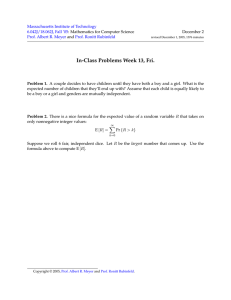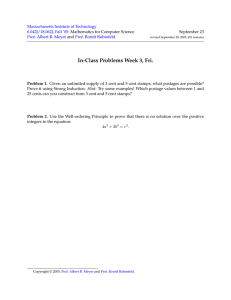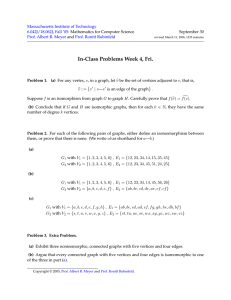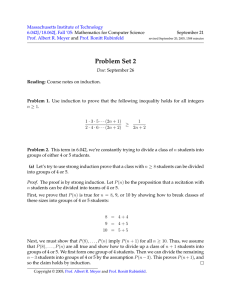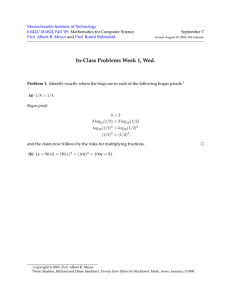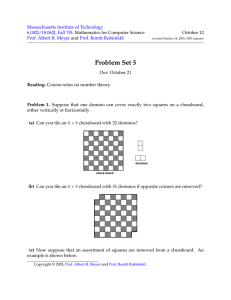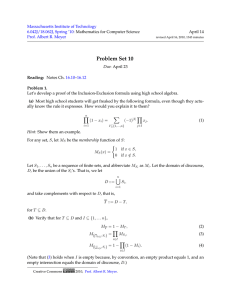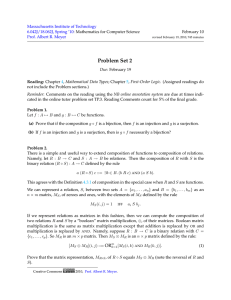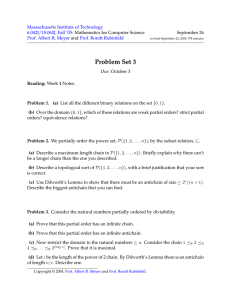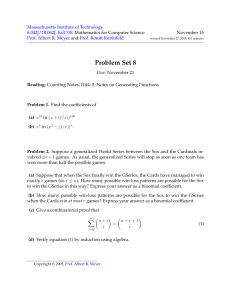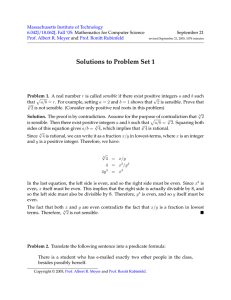: Mathematics for Computer Science September 9 and Massachusetts Institute of Technology
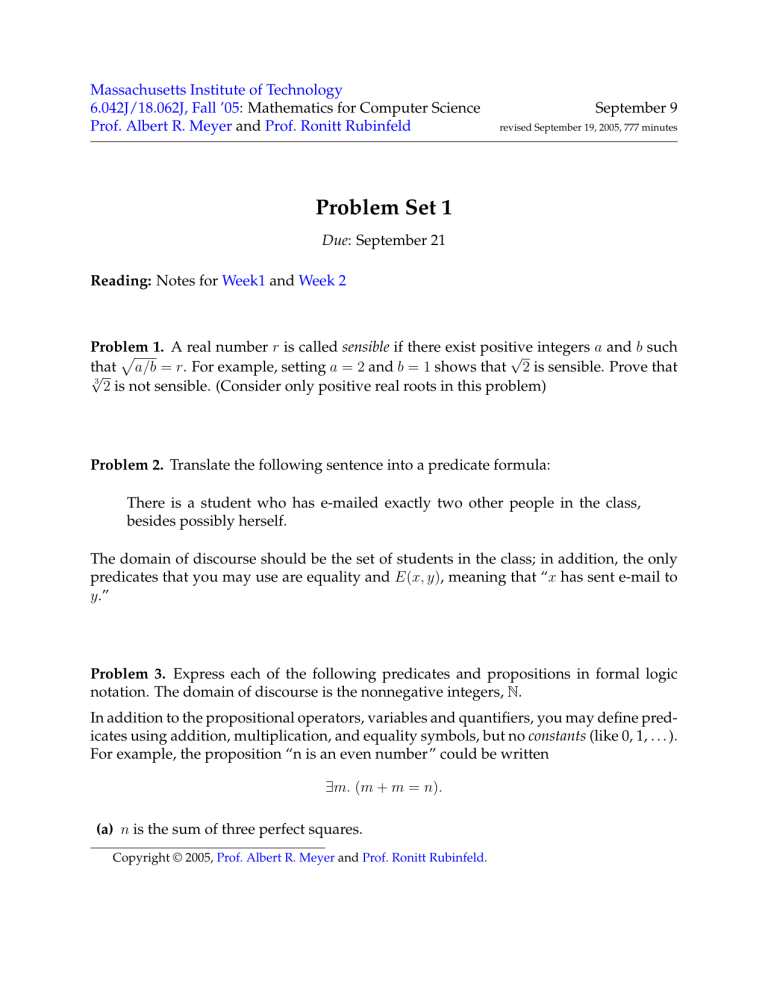
Massachusetts Institute of Technology
6.042J/18.062J, Fall ’05 : Mathematics for Computer Science
Prof.
Albert R.
Meyer and Prof.
Ronitt Rubinfeld
September 9 revised September 19, 2005, 777 minutes
Problem Set 1
Due : September 21
Reading: Notes for Week1 and Week 2
Problem 1.
A real number r is called sensible if there exist positive integers a and b such
� that
3 a/b = r .
For example, setting a = 2 and b = 1 shows that 2 is
2 is not sensible.
(Consider only positive real roots in this problem) sensible.
Prove that
Problem 2.
Translate the following sentence into a predicate formula:
There is a student who has emailed exactly two other people in the class, besides possibly herself.
The domain of discourse should be the set of students in the class; in addition, the only predicates that you may use are equality and E ( x, y ) , meaning that “ x has sent email to y .”
Problem 3.
Express each of the following predicates and propositions in formal logic notation.
The domain of discourse is the nonnegative integers,
N
.
In addition to the propositional operators, variables and quantifiers, you may define pred icates using addition, multiplication, and equality symbols, but no constants (like 0, 1, .
.
.
).
For example, the proposition “n is an even number” could be written
∃ m. ( m + m = n ) .
(a) n is the sum of three perfect squares.
Copyright © 2005, Prof.
Albert R.
Meyer and Prof.
Ronitt Rubinfeld .
Problem Set 1 2
Since the constant 0 is not allowed to appear explicitly, the predicate “ x = 0 ” can’t be written directly, but note that it could be expressed in a simple way as: x + x = x.
Then the predicate x > y could be expressed
∃ w .
( y + w = x ) ∧ ( w = 0) .
Note that we’ve used “ w = 0 ” in this formula, even though it’s technically not allowed.
But since “ w = 0 ” is equivalent to the allowed formula “ ¬ ( w + w = w ) ,” we can use
“ w = 0 ” with the understanding that it abbreviates the real thing.
And now that we’ve shown how to express “ x > y ”, it’s ok to use it too.
(b) x > 1 .
(c) n is a prime number.
(d) n is a product of two distinct primes.
(e) There is no largest prime number.
(f) (Goldbach Conjecture) Every even natural number n > 2 can be expressed as the sum of two primes.
(g) (Bertrand’s Postulate) If n > 1 , then there is always at least one prime p such that n < p < 2 n .
Problem 4.
If a set, A , is finite, then | | 2
| A |
= |P ( A ) | , and so there is no surjection from set A to its powerset.
Show that this is still true if A is infinite.
Hint: Remember Russell’s paradox and consider { x ∈ | f ( x ) } where f is such a surjection.
Problem 5.
(a) Prove that
∃ z.
[ P ( z ) ∧ Q ( z )] −→ [ ∃ x. P ( x ) ∧ ∃ y. Q ( y )] (1) is valid.
(Use the proof in the subsection on Validity in Week 2 Notes as a guide to writing your own proof here.)
(b) Prove that the converse of
is not valid by describing a counter model as in Week
2 Notes.
Problem Set 1
Problem 6.
(a) Give an example where the following result fails:
False Theorem.
For sets A , B , C , and D , let
L ::= ( A ∪ C ) × ( B ∪ D ) ,
R ::= ( A × B ) ∪ ( C × D ) .
Then L = R .
3
(b) Identify the mistake in the following proof of the False Theorem.
Bogus proof.
Since L and R are both sets of pairs, it’s sufficient to prove that ( x, y ) ∈ L
( x, y ) ∈ R for all x, y .
←→
The proof will be a chain of iff implications:
( x, y ) ∈ L iff x ∈ A ∪ C and y ∈ B ∪ D , iff either x ∈ A or x ∈ C , and either y ∈ B or y ∈ D , iff
( x ∈ A and y ∈ B ) or else ( x ∈ C and y ∈ D ),
( x, y ) ∈ A × B , or ( x, y ) ∈ C × D ,
( x, y ) ∈ ( A × B ) ∪ ( C × D ) = R .
iff iff
(c) Fix the proof to show that R ⊆ L .
Massachusetts Institute of Technology
6.042J/18.062J, Fall ’05 : Mathematics for Computer Science
Prof.
Albert R.
Meyer and Prof.
Ronitt Rubinfeld
Solutions cover sheet
September 9
Student’s Solutions to Problem Set 1
Your name:
Due date: September 21
Submission date:
Circle your TA : David Jelani Sayan
Collaboration statement: Circle one of the two choices and provide all pertinent info.
1.
I worked alone and only with course materials.
2.
I collaborated on this assignment with: got help
and referred
DO NOT WRITE BELOW THIS LINE
Problem Score
1
2
5
6
3
4
Total
Copyright © 2005, Prof.
Albert R.
Meyer and Prof.
Ronitt Rubinfeld .
1 People other than course staff.
2 Give citations to texts and material other than the Fall ’02 course materials.
